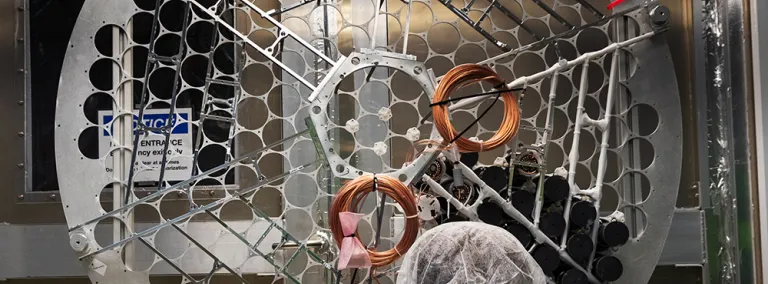Success of experiment requires testing
LZ researchers do everything they can to ensure their ultra-sensitive dark matter experiment runs right.
“The LZ detector is kind of like a spacecraft,” said Tomasz Biesiadzinski, project scientist for SLAC National Accelerator Laboratory (SLAC). “Repairing it after it's installed would be very difficult, so we do everything we can to make sure it works correctly the first time.”
Biesiadzinski himself is responsible for planning and carrying out tests during the assembly of the time projection chamber (TPC), the main detector for LUX-ZEPLIN experiment (LZ). Currently being constructed on the 4850 Level at Sanford Underground Research Facility (Sanford Lab), this main detector consists of a large tank that will hold 7 tonnes of ultra-pure, cryogenic liquid xenon maintained at -100o C. All the pieces of this detector are designed to function with precision; it is Biesiadzinski's job to verify that each part continues to work correctly as they are integrated. That includes hundreds of photomultiplier tubes (PMT).
Test run
The most recent test was piecing together an intricate mock array for the PMTs, which will detect light signals created by the collision of a dark matter particle and a xenon atom, inside the main detector. In a soft-wall cleanroom in the Surface Laboratory at Sanford Lab, Biesiadzinski and his team carefully practiced placing instruments like thermometers, sensors and reflective covering. They practiced installing routing cabling, including PMT high voltage power cables, PMT signal cables and thermometer cables.
“Essentially, we wanted to gain experience so we could be faster during the actual assembly. The faster we work, the more we limit dust exposure and therefore potential backgrounds,” said Biesiadzinski. “It was also an opportunity to test fit real components. We did find that there were some very tight places that motivated us to slightly redesign some small parts to make assembly easier.”
These tests will make the installment of the actual LZ arrays much smoother.
“LZ’s main detector will have two PMT arrays, one on the top of the tank and one on the bottom,” Biesiadzinski explained. “The bottom array will hold 241 PMTs pointing up into the liquid xenon volume of the main detector. The top array will hold PMTs 253 pointing down on the liquid xenon and the gas layer above it in the main detector.”
In total, there will be 494 PMTs lining the main detector. If a WIMP streaks through the tank and strikes a xenon nucleus, two things will happen. First, the xenon will emit a flash of light. Then, it will release electrons, which drift in an electric field to the top of the tank, where they will produce a second flash of light. Hundreds of PMTs will be waiting to detect a characteristic combination of flashes from inside the tank—a WIMPs’ telltale signature.
“Both arrays—top and bottom—record the light from particle interactions inside the detector, including, hopefully, dark matter,” said Biesiadzinski. “This data allows us to estimate both the energy created and 3D location of the interaction.”
Catching light
The PMTs used for LZ are extremely sensitive. Not only can they distinguish individual photons of light arriving just a few tens of nanoseconds apart, they can also see the UV light produced by xenon that is far outside the human vision range. The X-Y location of events in the detector can be measured using the top PMT array to within a few millimeters for sufficiently energetic events.
To ensure every bit of light makes its way to a PMT, the inside surfaces of the arrays are covered with Polytetrafluoroethylene (PTFE or teflon), a material highly reflective to xenon scintillation light, in between the PMT faces.
“This way, photons that don't enter the PMTs right away—and are therefore not recorded—are reflected and will get a second, third, and so on, chance of being detected as they bounce around the detector,” said Biesiadzinski.
Researchers will also cover the outside of the bottom array, including all of the cables, with PTFE to maximize light collection there. Light recorded there by additional PMTs that are not part of the array, allow us to measure radioactive backgrounds that can contaminate the main detector.
Keeping it “clean”
In addition to being very specific, these PMTs are also ultra-clean.
“By clean, we mean radio-pure,” said Brianna Mount, director of the BHUC, where 338 of LZ’s PMTs have already been tested for radio-purity.
The tiniest amounts of radioactive elements in the very materials used to construct LZ can also overwhelm the rare-event signal. Radioactive elements can be found in rocks, titanium—even human sweat. As these elements decay, they emit signals that quickly light up ultra-sensitive detectors. To lessen these misleading signatures, researchers assay, or test, their materials for radio-purity using low-background counters (LBCs).
“Our PMTs are special made to have very low radioactivity so as to not overwhelm a very sensitive detector like LZ with background signal,” said Biesiadzinski.
Testing the PMTs at the BHUC allows researchers to understand exactly how much of a remaining background they can expect to see from these materials during the experiment. Mount explained that most of the samples currently being assayed at the BHUC are LZ samples, including cable ties, wires, nuts and bolts.
“We have assayed every component that will make up LZ,” said Kevin Lesko, senior physicist at Lawrence Berkeley National Lab (Berkeley Lab) and a spokesperson for LZ. “At this point we have performed over 1300 assays with another 800 assays planned. These have kept BHUC and the UK’s Boulby LBCs fully occupied for approximately 4 years. These assays permit us to ensure no component contributes a major background to the detector and also allows us to assemble a model of the backgrounds for the entire detector before we turn on a single PMT.”
For a visual description and breakdown of LZ’s design, watch this video created by SLAC.
